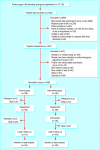Multifactorial intervention after a fall in older people with cognitive impairment and dementia presenting to the accident and emergency department: randomised controlled trial
- PMID: 12521968
- PMCID: PMC139930
- DOI: 10.1136/bmj.326.7380.73
Multifactorial intervention after a fall in older people with cognitive impairment and dementia presenting to the accident and emergency department: randomised controlled trial
Erratum in
- BMJ. 2003 Mar 29;326(7391):699
Abstract
Objective: To determine the effectiveness of multifactorial intervention after a fall in older patients with cognitive impairment and dementia attending the accident and emergency department.
Design: Randomised controlled trial.
Participants: 274 cognitively impaired older people (aged 65 or over) presenting to the accident and emergency department after a fall: 130 were randomised to assessment and intervention and 144 were randomised to assessment followed by conventional care (control group).
Setting: Two accident and emergency departments, Newcastle upon Tyne.
Main outcome measures: Primary outcome was number of participants who fell in year after intervention. Secondary outcomes were number of falls (corrected for diary returns), time to first fall, injury rates, fall related attendances at accident and emergency department, fall related hospital admissions, and mortality.
Results: Intention to treat analysis showed no significant difference between intervention and control groups in proportion of patients who fell during 1 year's follow up (74% (96/130) and 80% (115/144), relative risk ratio 0.92, 95% confidence interval 0.81 to 1.05). No significant differences were found between groups for secondary outcome measures.
Conclusions: Multifactorial intervention was not effective in preventing falls in older people with cognitive impairment and dementia presenting to the accident and emergency department after a fall.
Comment in
-
A multifactorial intervention after a fall did not prevent falls in elderly patients with cognitive impairment and dementia.Evid Based Nurs. 2003 Oct;6(4):114-5. Evid Based Nurs. 2003. PMID: 14577396 No abstract available.
References
-
- Tinetti ME, Speechley M, Ginter SF. Risk factors for falls among elderly persons living in the community. N Engl J Med. 1988;319:1701–1707. - PubMed
-
- Van Dijk PTM, Meulenberg OGRM, Van De Sande HJ, Habbema JDF. Falls in dementia patients. Gerontologist. 1993;33:200–204. - PubMed
-
- Davies AJ, Kenny RA. Falls presenting to the accident and emergency department: types of presentation and risk factor profile. Age Ageing. 1996;25:362–366. - PubMed
-
- Department of Health. National service framework for older people. London: Department of Health; 2001. pp. 76–89.
-
- Folstein MF, Folstein SE, McHugh PR. Mini-mental state. A practical method for grading the cognitive state of patients for the clinician. J Psychiatr Res. 1975;12:189–198. - PubMed
Publication types
MeSH terms
LinkOut - more resources
Full Text Sources
Medical

